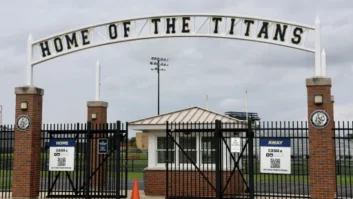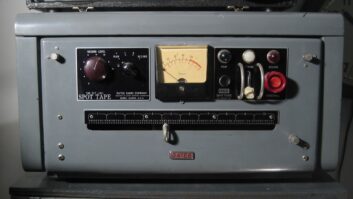One in a series of occasional articles reviewing notable new or recent books about radio.
Jim Cox is a retired college professor who has written a number of books with radio as the subject matter. “American Radio Networks: A History” is his 18th book.
In this 2009 work, published by McFarland and retailing for $45, Cox takes the reader back to the very beginning of time as concerns the interconnecting of radio stations for the purpose of carrying the same program simultaneously.

I was looking forward to reading this one. While there’s a lot of information available in the way of early radio station history, the same isn’t true about the networks that linked many of these stations to the large broadcasting centers in places such as New York, Los Angeles and Chicago.
Cox does present a lot of interesting and useful history about stations and networks, but as I continued to read, I began to be a bit disappointed.
Low-tech
Perhaps I expected too much, but I was hoping for at least a “smidgeon” of information about the technical nature of the networking arrangements (mostly by Ma Bell’s AT&T Long Lines division; something that ceased to exist around 1980 or so). However, there is nary a trace of this in the book.
If you want to read about the politics, fiscal situation or programs associated with the halcyon days of networking radio stations together, the book has plenty of this.
However, if you’re wanting to know what the tariffed audio bandpass delivery to a typical National Broadcasting Company Network affiliate was, or maybe what the CBS NetALERT system was all about, or perhaps just what AT&T had to do to prep a cross-country copper pair for radio program audio, you won’t find it.
And while I like Cox’s writing style — it’s fresh and lively — one aspect of the book is irritating to an old broadcasting curmudgeon such as myself, and that’s his incessant use of the word “web” when he means “network.”
I would agree that in the modern vernacular, the term “web” is used to describe a large wired or wireless interconnecting system — even more so today than the term network. However, nobody ever called a radio network a web connection back in the good old days when getting a signal cross-country cleanly to several hundred affiliates was still something of a challenge.
(Did Bill Paley’s group ever refer to their radio operation as the “The CBS Radio Web”? Don’t think so.)
Another minor gripe is Cox’s inclusion of what can best be termed filler.
One example is the chapter titled “The Halcyon Days.” It’s a very short compilation of network programming (45 shows) from radio’s “golden age.” By the time this chapter appears, Cox already has liberally “sprinkled” his pages with the names of, and information about, a goodly number of classic radio shows.
Information on programs is available in several other works in a much more complete fashion. There’s quite a bit of other material that is, in my opinion, superfluous.
Zingers
Cox, in his preface, devotes a paragraph to the philosophy of producing an error-free book.
He admits that even though he’s done his best to ensure that “American Radio Networks” is squeaky clean, some zingers are bound to slip through, leaving it up to readers to spot them. I found several, which hopefully will be cleared should there be another printing.
One of the more glaring appears a mere 13 pages into the book, with the author locating station KSD in Kansas City; just a few pages later he puts it back in its correct St. Louis city of license.
In the chapter on television networks (not really sure why this was needed in a book about radio, as we all know it was the growth of television that killed off network radio’s “golden age”), Cox asserts that the television 1948 “freeze” was ordered by the FCC due to an overload of new station applications.
I believe history shows that the real reason applications were frozen was that the commission had gotten it wrong, with the number of short-spaced TV transmitters having increased to the point of interfering with each other.
He also says that the FCC “quickly” approved the CBS (field sequential) color TV system. Actually CBS first began lobbying for approval in the early 1940s and formally petitioned the commission for adoption in 1946. Hearings didn’t get underway until mid-1949, and the green light wasn’t given until October of 1950.
I’m sure too that surviving Hazeltine Labs engineers (and other members of the second NTSC) would be upset to read that the color system ultimately adopted (NTSC) was “a modification of an RCA-originated schematic.”
While the majority of Cox’s book is well researched and written, it falls a bit short for those of us who might want to learn more about the technical side of delivering programs from major network production centers to the affiliates throughout the country (and beyond), when putting up a small dish antenna just outside the station’s back door wasn’t an option.
I suppose that’s a book that has yet to be written.
James O’Neal is technology editor for TV Technology and a frequent Radio World contributor. He wrote about microphone repair expert Clarence Kane in the Dec. 1, 2010, issue.







